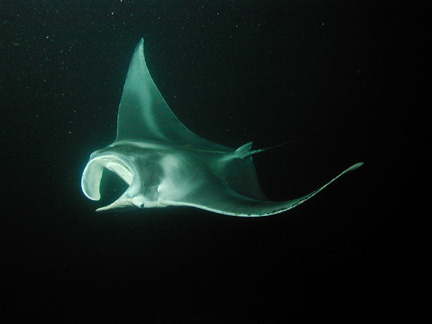
|
Open danger
Isle manta rays are vulnerable
to extinction, and advocates are
looking to enact legislation to
guard against dangers
KAILUA-KONA » Koie was in trouble. The female manta ray, a regular visitor along the Kona Coast, showed up in July with fishing line wrapped tightly around her right wing.
Divers from several local tour companies were ready to help, but she disappeared.
Then, at the end of September, the graceful and gentle filter-feeder returned as suddenly as she had disappeared.
Keller Laros, co-founder of the Manta Pacific Research Foundation and an underwater videographer, joined three other divers in clipping away the line. Koie swooped in time and time again, allowing the divers to completely remove the line and a hook.
"She would have lost her wing and probably would have died," Laros said. "She trusted us to do that. You could tell she was happy to get it off."
Laros is among a growing number of advocates and scientists concerned about Hawaii's manta ray population.
Currently, Hawaii has no laws protecting manta rays, and although the state does not have a tradition of manta fishing, advocates warn such an industry could mushroom as overfishing depletes populations in Indonesia, the Philippines and Mexico.
Manta meat is a delicacy in some Asian countries, and demand is growing in Asian markets for dried manta products to use in alternative medicines.
A resolution directing the state Department of Land and Natural Resources to study the feasibility of establishing penalties for the capture or destruction of mantas died in the Legislature this year.
Laros said he plans to lobby for the bill next year but cautioned it might be too late for the giant fish, which measure up to 14 feet wingtip to wingtip and essentially are harmless to humans.
"If someone suddenly decides to come in and fish for them, they'll be gone and they won't come back," he said. "We could have curtailed any threat this year. It's a no-brainer."
Tim Clark, a University of Hawaii-Manoa graduate student and marine biologist, said protecting mantas should be a priority because they do not migrate, and each female produces only one pup every couple of years.
"Globally, there are fisheries that are going to systematically wipe out the populations one by one," Clark said, adding that the populations off West Hawaii, Oahu and Maui are in "open danger" and could be fished into extinction within one month.
Scientists want to add mantas to an existing international United Nations-backed treaty that restricts trading and trafficking, Clark said.
That will not happen until at least 2007. Hawaii and Yap, in the Federated States of Micronesia, are the top spots in the world to view mantas, which typically live in tropical waters within 35 degrees of the equator.
In 2002, 11,000 people snorkeled and scuba-dived with mantas on the Big Island, according to the Manta Pacific Research Foundation. This generated $920,000 in direct and $2.4 million in indirect revenue for the state.
"Manta rays really are the backbone of the Kona dive industry," Clark said. "Economically, there are a lot of people making a living off them."
Since 1993, Kona Coast companies that offer viewing tours have followed a set of self-written guidelines and voluntarily enforce strict no-touch policies.
James Wing, a self-described naturalist and underwater explorer who has been studying the creatures for more than a decade, said he has identified about 100 regular visitors.
He also is the West Hawaii representative for the Manta Network, a nonprofit organization dedicated to the protection and conservation of mantas worldwide.
"Mantas are an enigma, difficult to study and almost impossible to hold in captivity," Wing said.
[News] [Business] [Features] [Sports] [Editorial] [Do It Electric!]
[Classified Ads] [Search] [Subscribe] [Info] [Letter to Editor]
[Feedback]
